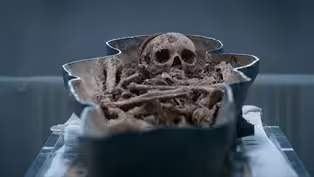
Who is the Mystery Man Buried Under Notre Dame?
Clip: Season 51 Episode 18 | 3mVideo has Closed Captions
Can scientists identify the man buried inside a mysterious coffin found under Notre Dame?
A mysterious coffin found beneath the damaged floor of Notre Dame is full of unexpected discoveries. The lead sarcophagus appears to have been moved and there are no identifying markers. Who is the John Doe buried inside? Follow scientists on a forensic journey as they collect enamel from the teeth and a few grams of bone to try to discover the identity of the mystery man buried under Notre Dame.
Problems playing video? | Closed Captioning Feedback
Problems playing video? | Closed Captioning Feedback
National Corporate funding for NOVA is provided by Carlisle Companies and Viking Cruises. Major funding for NOVA is provided by the NOVA Science Trust, the Corporation for Public Broadcasting, and PBS viewers.

Who is the Mystery Man Buried Under Notre Dame?
Clip: Season 51 Episode 18 | 3mVideo has Closed Captions
A mysterious coffin found beneath the damaged floor of Notre Dame is full of unexpected discoveries. The lead sarcophagus appears to have been moved and there are no identifying markers. Who is the John Doe buried inside? Follow scientists on a forensic journey as they collect enamel from the teeth and a few grams of bone to try to discover the identity of the mystery man buried under Notre Dame.
Problems playing video? | Closed Captioning Feedback
How to Watch NOVA
NOVA is available to stream on pbs.org and the free PBS App, available on iPhone, Apple TV, Android TV, Android smartphones, Amazon Fire TV, Amazon Fire Tablet, Roku, Samsung Smart TV, and Vizio.
Buy Now

NOVA Labs
NOVA Labs is a free digital platform that engages teens and lifelong learners in games and interactives that foster authentic scientific exploration. Participants take part in real-world investigations by visualizing, analyzing, and playing with the same data that scientists use.Providing Support for PBS.org
Learn Moreabout PBS online sponsorship- [Narrator] Human remains.
A sealed lead sarcophagus of unknown age.
Finding bodies is not completely unexpected.
Burials in and around the cathedral are part of its history, but a sarcophagus like this one is very rare and immediately begs the questions, "Whose remains are these" and "Why are they here?"
This coffin is full of unexpected discoveries.
His remains will be the subject of a much more detailed analysis.
By collecting enamel from the teeth and a few grams of bone from a fingertip, it is possible to find clues to where he grew up.
It's called isotopic analysis.
Our bodies are made from the carbon and other chemical elements we take in when we eat and breathe.
Among the atoms of those elements, there are variations called isotopes.
The isotopes of strontium, oxygen and sulfur can point to the geographical location where someone grew up.
And nitrogen and carbon can help determine if he ate mostly fish or meat throughout his life.
Anthropologist, Rozenn Colleter and geochemistry researcher, Klervia Jaouen, process the samples of enamel and bone collected from the remains.
In order to extract the chemical isotopes that will tell the story of where he lived, they first soak the samples in an acid bath to break down the material.
The acid causes the bone samples to become soft, allowing researchers to extract a protein, collagen.
(intense music) Once concentrated, these collagen molecules are placed in small tin capsules to be analyzed by a mass spectrometer.
A few months later, they receive the first results.
- [Interpreter] So this is a map showing the probabilities for oxygen's.
- [Interpreter] Ah, it's much more pronounced.
- [Interpreter] Once again Paris, here.
And in terms of probability, we can see that the higher values are further east in France.
- [Narrator] The analysis says the mystery man grew up in the east of France.
This result matches with the little information the archeologists gathered so far about Edouard de la Madeleine, who belonged to a noble family based in Burgundy.
(intense music)
Lost Tombs of Notre Dame Preview
Video has Closed Captions
Preview: S51 Ep18 | 30s | Mysterious bodies are found under one of the world’s most famous cathedrals. (30s)
Providing Support for PBS.org
Learn Moreabout PBS online sponsorship
- Science and Nature

Capturing the splendor of the natural world, from the African plains to the Antarctic ice.













Support for PBS provided by:
National Corporate funding for NOVA is provided by Carlisle Companies and Viking Cruises. Major funding for NOVA is provided by the NOVA Science Trust, the Corporation for Public Broadcasting, and PBS viewers.



